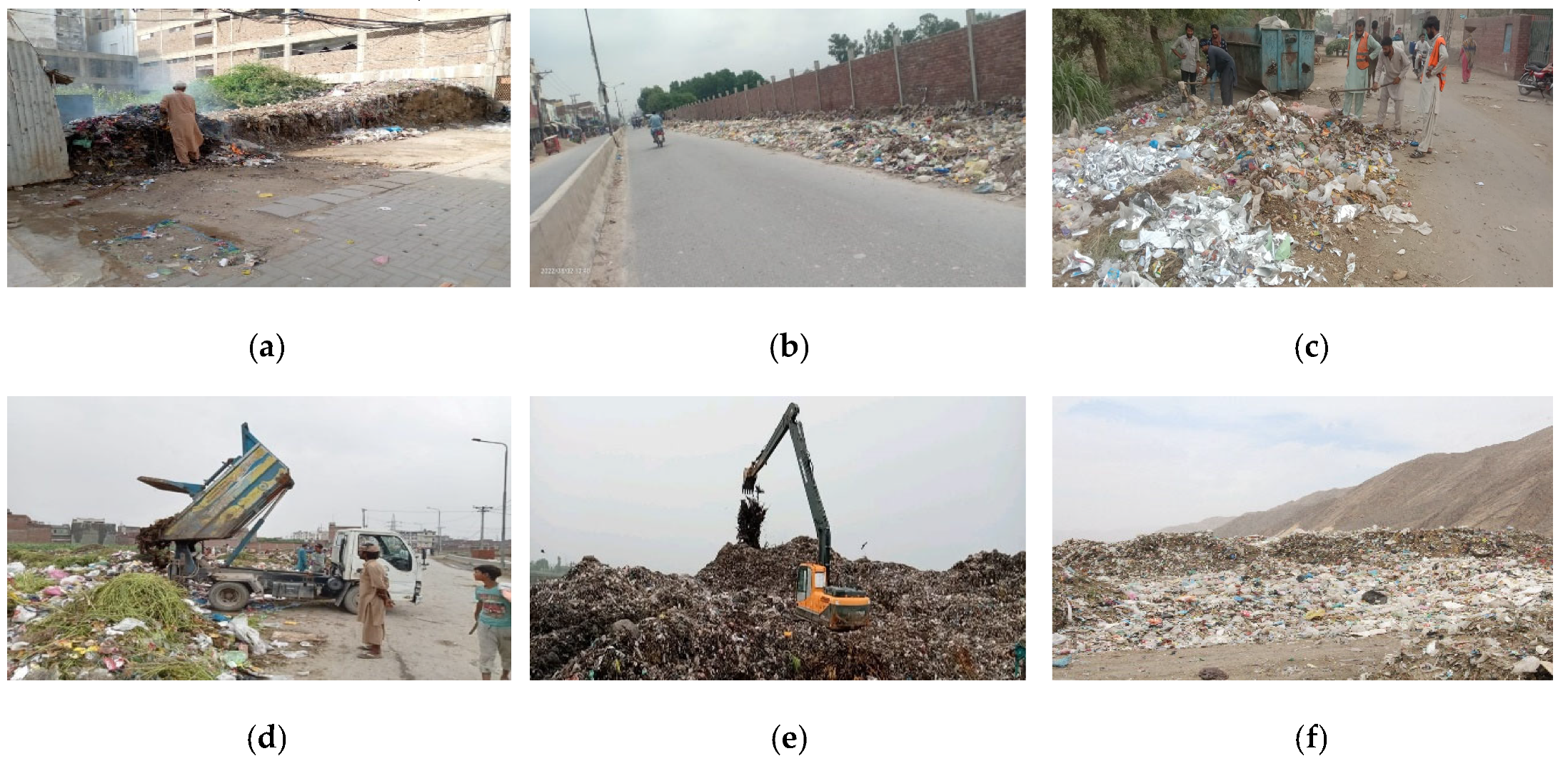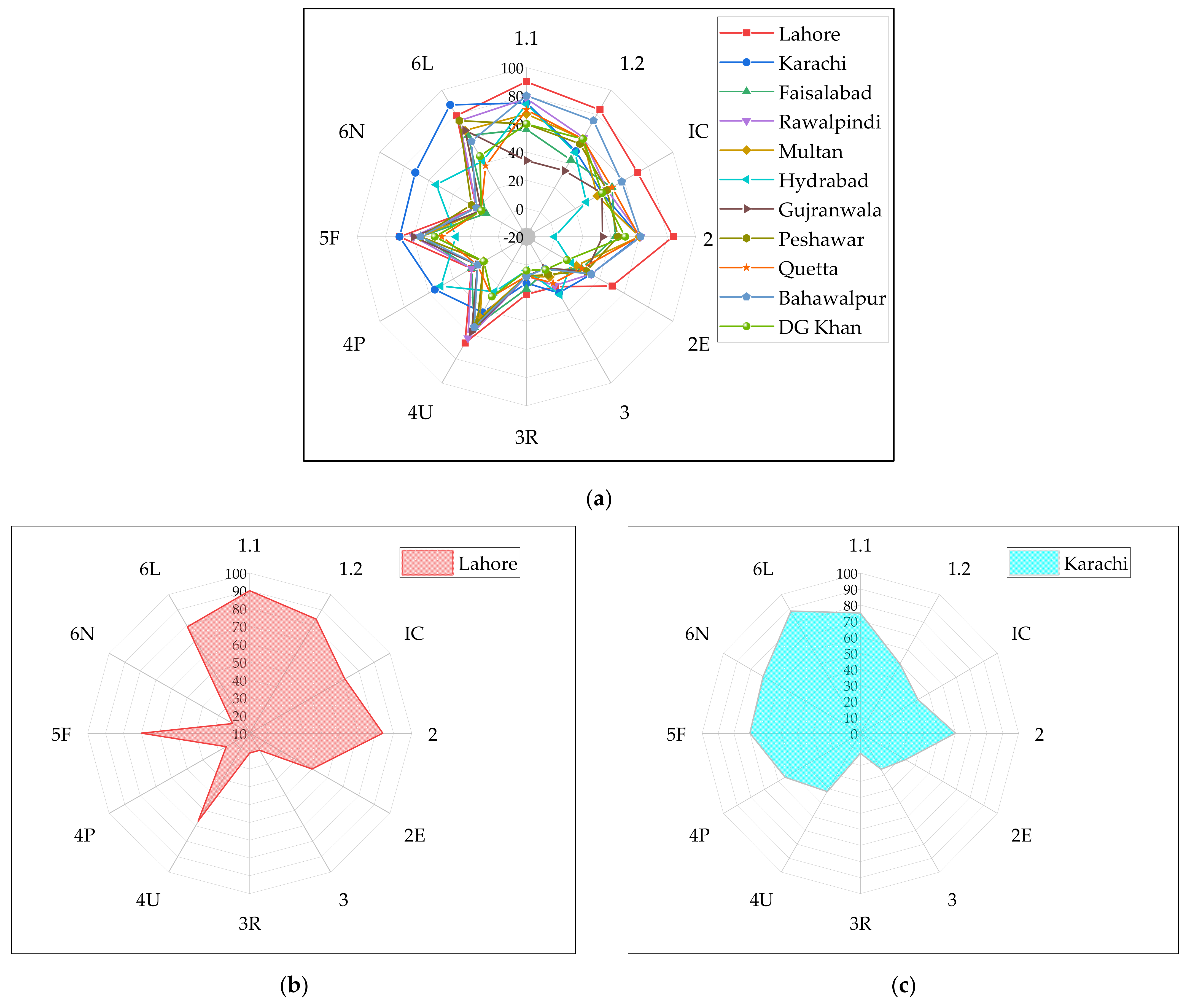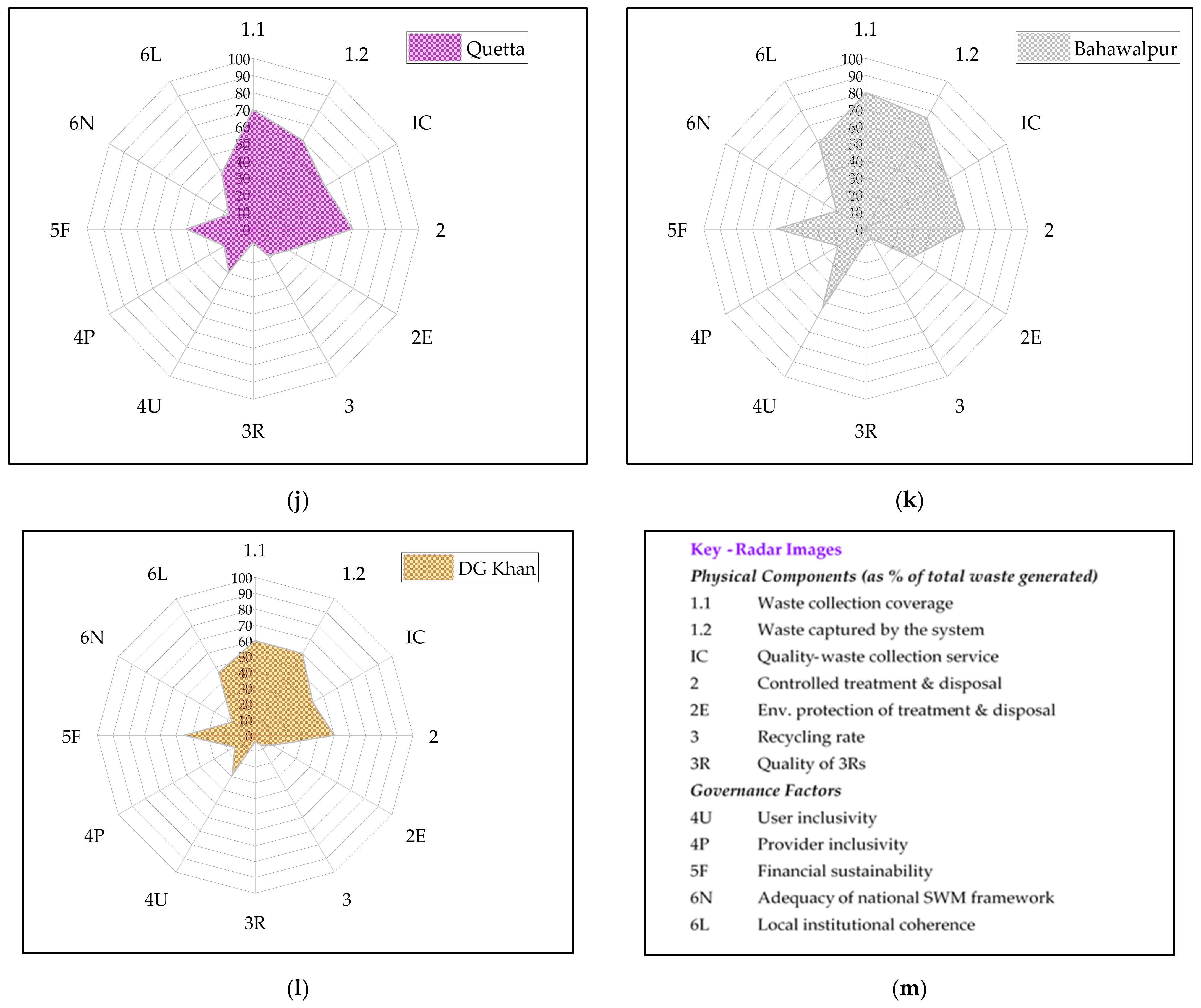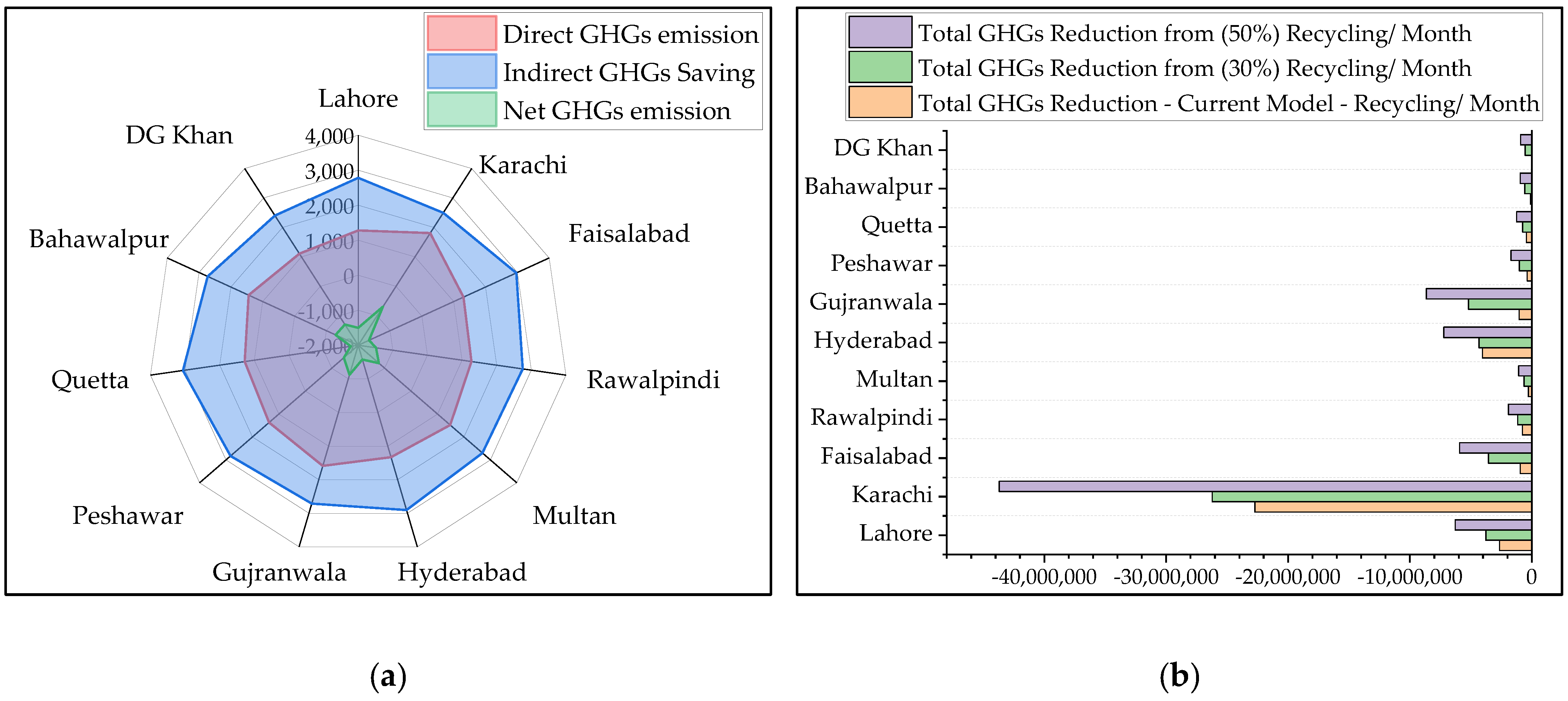Assessment of Solid Waste Management System in Pakistan and Sustainable Model from Environmental and Economic Perspective
Abstract
1. Introduction
- Establishing public sector WMCs across Punjab province;
- Forming Sindh SWM Board;
- Water and Sanitation Services Companies in Khyber Pakhtunkhwa (KPK) province;
- Addition of a new fleet in Quetta, Baluchistan and Punjab;
- Outsourcing waste collection services locally and internationally in various cities.
2. Materials and Methods
2.1. Proposed SWM Model for Pakistan
2.2. Environmental Modelling for GHGs Emission
2.3. Economic Modelling
3. Results
3.1. Performance Evaluation of SWM Model in Pakistan
3.1.1. Background Information and Key Waste Related Data
3.1.2. Analysis of Physical Components
3.1.3. Evaluation of Governance Factor
3.1.4. Greenhouse Gases (GHGs) Emission from Current Waste Disposal Practices
3.2. Proposed Sustainable SWM Model for Pakistan
- Enhancing the number of trips for existing SWM vehicles, adding some new fleet and equipment, and focusing on repair and maintenance will increase waste collection efficiency minimum at a level of more than 85%;
- Three waste streams, i.e., residential, commercial and institutional, and bulk waste for separate and dedicated waste collection arrangements, will help in quality composting and separation of precious recyclables;
- Identification of state land or procurement of land for waste transfer stations and waste treatment facilities;
- Meanwhile, it is appropriate to have interim arrangements for TCPs per a transfer station’s criteria;
- Establishment of the composting facility for 20% organic waste proportion;
- Exploration of the business model of the informal sector for its integration with the formal system.
- Identification and procurement of lands for disposal of waste;
- Establishment of an MRF to cater to 30% of recyclables;
- Arrangements for gas capturing system and flaring of GHGs from current and old dumpsites;
- Utilization of dry municipal sludge as interim soil cover at dumpsites and debris waste for infrastructure development of facilities, i.e., TCPs and disposal sites;Enhancement of MRF facility for recovery of recyclables up to 50%.
3.2.1. Environmental Sustainability of Sector
3.2.2. Recovery of Recyclables
3.2.3. Manufacturing of Compost from Organic Waste
3.2.4. Economic Sustainability of Sector
4. Discussions
5. Conclusions
Supplementary Materials
Author Contributions
Funding
Institutional Review Board Statement
Informed Consent Statement
Data Availability Statement
Acknowledgments
Conflicts of Interest
Appendix A. Wasteware ISWM Benchmarking Indicators—Assessment of Eleven Major Cities of Pakistan

References
- Ferronato, N.; Pasinetti, R.; Valencia Vargas, D.; Calle Mendoza, I.J.; Guisbert Lizarazu, E.G.; Gorritty Portillo, M.A.; Conti, F.; Torretta, V. Circular economy, international cooperation, and solid waste management: A development project in La Paz (Bolivia). Sustainability 2022, 14, 1412. [Google Scholar] [CrossRef]
- Debrah, J.K.; Vidal, D.G.; Dinis, M.A. Raising awareness on solid waste management through formal education for sustainability: A developing countries evidence review. Recycling 2021, 6, 6. [Google Scholar] [CrossRef]
- Vaccari, M.; Torretta, V.; Collivignarelli, C. Effect of improving environmental sustainability in developing countries by upgrading solid waste management techniques: A case study. Sustainability 2012, 4, 2852–2861. [Google Scholar] [CrossRef]
- Ferronato, N.; Torretta, V. Waste mismanagement in developing countries: A review of global issues. Int. J. Environ. Health Res. 2019, 16, 1060. [Google Scholar] [CrossRef] [PubMed]
- Scarlat, N.; Fahl, F.; Dallemand, J.F. Status and opportunities for energy recovery from municipal solid waste in Europe. Waste Biomass Valoriz. 2019, 10, 2425–2444. [Google Scholar] [CrossRef]
- Bello, A.S.; Al-Ghouti, M.A.; Abu-Dieyeh, M.H. Sustainable and long-term management of municipal solid waste: A review. Bioresour. Technol. Rep. 2022, 18, 101067. [Google Scholar] [CrossRef]
- Pakistan Bureau of Statistics, Government of Pakistan. Available online: https://www.pbs.gov.pk/content/population-census (accessed on 1 September 2022).
- Permana, A.S.; Towolioe, S.; Abd Aziz, N.; Ho, C.S. Sustainable solid waste management practices and perceived cleanliness in a low income city. Habitat Int. 2015, 49, 197–205. [Google Scholar] [CrossRef]
- Sohoo, I.; Ritzkowski, M.; Sohu, Z.A.; Cinar, S.Ö.; Chong, Z.K.; Kuchta, K. Estimation of methane production and electrical energy generation from municipal solid waste disposal sites in Pakistan. Energies 2021, 14, 2444. [Google Scholar] [CrossRef]
- Jerin, D.T.; Sara, H.H.; Radia, M.A.; Hema, P.S.; Hasan, S.; Urme, S.A.; Audia, C.; Hasan, M.T.; Quayyum, Z. An overview of progress towards implementation of solid waste management policies in Dhaka, Bangladesh. Heliyon 2022, 8, e08918. [Google Scholar] [CrossRef]
- Ferronato, N.; D’Avino, C.; Ragazzi, M.; Torretta, V.; De Feo, G. Social surveys about solid waste management within higher education institutes: A comparison. Sustainability 2017, 9, 391. [Google Scholar] [CrossRef]
- Rolewicz-Kalińska, A.; Lelicińska-Serafin, K.; Manczarski, P. The circular economy and organic fraction of municipal solid waste recycling strategies. Energies 2020, 13, 4366. [Google Scholar] [CrossRef]
- Rupani, P.F.; Delarestaghi, R.M.; Abbaspour, M.; Rupani, M.M.; El-Mesery, H.S.; Shao, W. Current status and future perspectives of solid waste management in Iran: A critical overview of Iranian metropolitan cities. Environ. Sci. Pollut. Res. 2019, 26, 32777–32789. [Google Scholar] [CrossRef]
- Dickie, G. Landfills around the World Release a Lot of Methane: Study. Source: Reuters. Available online: https://www.reuters.com/business/environment/landfills-around-world-release-lot-methane-study-2022-08-10/#:~:text=High%2Dresolution%20satellite%20images%20snapped,in%20the%20journal%20Science%20Advances (accessed on 1 September 2022).
- Kaza, S.; Yao, L.; Bhada-Tata, P.; Van Woerden, F. What a Waste 2.0: A Global Snapshot of Solid Waste Management to 2050; World Bank Publications: Washington, DC, USA, 2018; ISBN 1-4648-1347-7. [Google Scholar]
- Maasakkers, J.D.; Varon, D.J.; Elfarsdóttir, A.; McKeever, J.; Jervis, D.; Mahapatra, G.; Pandey, S.; Lorente, A.; Borsdorff, T.; Foorthuis, L.R.; et al. Using satellites to uncover large methane emissions from landfills. Sci. Adv. 2022, 8, eabn9683. [Google Scholar] [CrossRef] [PubMed]
- Dlamini, S.; Simatele, M.D.; Serge Kubanza, N. Municipal solid waste management in South Africa: From waste to energy recovery through waste-to-energy technologies in Johannesburg. Local Environ. 2019, 24, 249–257. [Google Scholar] [CrossRef]
- Kabera, T.; Wilson, D.C.; Nishimwe, H. Benchmarking performance of solid waste management and recycling systems in East Africa: Comparing Kigali Rwanda with other major cities. Waste Manag. Res. 2019, 37, 58–72. [Google Scholar] [CrossRef] [PubMed]
- Rodić, L.; Wilson, D.C. Resolving governance issues to achieve priority sustainable development goals related to solid waste management in developing countries. Sustainability 2017, 9, 404. [Google Scholar] [CrossRef]
- National Initiative for Sustainable Development Goals. Available online: https://www.sdgpakistan.pk/ (accessed on 4 September 2022).
- Wilson, D.C.; Rodic, L.; Cowing, M.J.; Velis, C.A.; Whiteman, A.D.; Scheinberg, A.; Vilches, R.; Masterson, D.; Stretz, J.; Oelz, B. ‘Wasteaware’ benchmark indicators for integrated sustainable waste management in cities. Waste Manag. 2015, 35, 329–342. [Google Scholar] [CrossRef]
- Javed, N.; Hobson, M. Urban Sector Inclusion in the Revised Nationally Determined Contributions of Pakistan. 2022. Available online: https://www.adb.org/publications/urban-sector-inclusion-ndcs-pakistan (accessed on 2 September 2022).
- Menikpura, N.; Sang-Arun, J. User Manual: Estimation Tool for Greenhouse Gas (GHG) Emissions from Municipal Solid Waste (MSW) Management in a Life Cycle Perspective; Institute for Global Environmental Strategies: Hayama, Japan, 2013. [Google Scholar]
- Aye, L.; Widjaya, E.R. Environmental and economic analyses of waste disposal options for traditional markets in Indonesia. Waste Manag. 2006, 26, 1180–1191. [Google Scholar] [CrossRef]
- The World Bank. Available online: https://data.worldbank.org/indicator/NY.GNP.PCAP.CD?locations=PK (accessed on 2 September 2022).
- Local Government Department, Government of Sindh. Waste Amount Characterization Survey; Preliminary Report; PPI Environmental and Management Consultant: Karachi, Pakistan, 2021; pp. 1–26.
- Lahore Waste Management Company. Available online: https://www.lwmc.com.pk/istacrole.php (accessed on 5 August 2022).
- Aslam, B.; Maqsoom, A.; Tahir, M.D.; Ullah, F.; Rehman, M.S.U.; Albattah, M. Identifying and ranking landfill sites for municipal solid waste management: An integrated remote sensing and GIS approach. Buildings 2022, 12, 605. [Google Scholar] [CrossRef]
- Yasin, H.; Usman, M.; Rashid, H.; Nasir, A.; Randhawa, I.A. Alternative approaches for solid waste management: A case study in Faisalabad Pakistan. Earth Sci. Pak. 2017, 7–9. [Google Scholar] [CrossRef]
- Infrastructure Project Development Facility. Solid Waste Management Project in Faisalabad on PPP Modality. MM Pakistan (Pvt.) Ltd., 2010; 1, pp. 4–25. Available online: https://mmpakistan.com/mmp/pages/sector-projects?id=4 (accessed on 8 September 2022).
- Ilmas, B.; Mir, K.A.; Khalid, S. Greenhouse gas emissions from the waste sector: A case study of Rawalpindi in Pakistan. Carbon Manag. 2018, 9, 645–654. [Google Scholar] [CrossRef]
- Rawalpindi Waste Management Company. Municipal Solid Waste Characterization Study for Rawalpindi. Consultancy by LWMC; 2016; pp. 4–27. Available online: https://lgcd.punjab.gov.pk/rawalpindi_waste_management_company (accessed on 8 September 2022).
- Arshad, R.; Shehzad, M.; Ahmed, M. Solid Waste Management: An Integrated Approach towards Sustainability in Multan. Available online: https://ejast.novuspublishers.org/wp-content/uploads/2021/09/010003EJAST.pdf (accessed on 2 September 2022).
- Shoaib, M.; Mirza, U.K.; Sarwar, M.A. Review and status of solid waste management practices in Multan, Pakistan. Electron. Green J. 2006, 1. [Google Scholar] [CrossRef]
- Ali, M.; Geng, Y.; Robins, D.; Cooper, D.; Roberts, W.; Vogtländer, J. Improvement of waste management practices in a fast expanding sub-megacity in Pakistan, on the basis of qualitative and quantitative indicators. Waste Manag. 2019, 85, 253–263. [Google Scholar] [CrossRef] [PubMed]
- City District Government Gujranwala. Project for integrated solid waste management master plan in Gujranwala. Consult. Jpn. Int. Corpor. Agency 2015, 1, 11–113. Available online: https://openjicareport.jica.go.jp/pdf/12246328_01.pdf (accessed on 2 September 2022).
- Mohsin, M.; Khan, A.A.; Nasar-u-Minallah, M.; Barkat, T. Assessment of municipal solid waste management practices in Bahawalpur city, Pakistan. Int. J. Econ. Environ. 2020, 11, 1–5. [Google Scholar] [CrossRef]
- Majeed, A.; Batool, S.A.; Chaudhry, M.N. Environmental quantification of the existing waste management system in a developing world municipality using EaseTech: The case of Bahawalpur, Pakistan. Sustainability 2018, 10, 2424. [Google Scholar] [CrossRef]
- The Urban Unit, Government of the Punjab. DG Khan City Profile. 2021; pp. 43–45. Available online: https://www.urbanunit.gov.pk/Download/publications/Files/8/2021/PCIIP%20Cities%20Profile-Dera%20Ghazi%20Khan.pdf (accessed on 7 September 2022).
- Waqas, M. The current status and steps towards sustainable waste management in the developing countries: A case study of Peshawar-Pakistan. Indones. J. Urban Environ. Technol. 2019, 3, 47–66. [Google Scholar] [CrossRef]
- Babar, A.R.; Khalid, Q.S.; Rashid Nawaz, I.A.; Azim, S. Capacity analysis of solid waste in Peshawar, Pakistan. Int. J. Sci. Res. 2021, 10, 22–26. [Google Scholar]
- Korai, M.S.; Mahar, R.B. Characterization and aerobic biological treatment of MSW: A case study of Hyderabad city. Mehran Univ. Res. J. Eng. Technol. 2014, 33, 322–329. [Google Scholar]
- Quetta Municipal Corporation. Municipal Solid Waste Characterization Study for Quetta. Consultancy by LWMC. 2015. Available online: https://mcq.gob.pk/ (accessed on 6 August 2022).
- Pujara, Y.; Pathak, P.; Sharma, A.; Govani, J. Review on Indian municipal solid waste management practices for reduction of environmental impacts to achieve sustainable development goals. J. Environ. Manag. 2019, 248, 109238. [Google Scholar] [CrossRef]
- Gichamo, T.; Gökçekuş, H. Interrelation between climate change and solid waste. J. Environ. Pollut. Control 2019, 2, 104. [Google Scholar]
- Zaidi, H.H. Global Economic Outlook and Pakistan. The Express Tribune. 2022. Available online: https://tribune.com.pk/story/2356762/global-economic-outlook-and-pakistan (accessed on 6 August 2022).
- 8Billiontree. Available online: https://8billiontrees.com/carbon-offsets-credits/new-buyers-market-guide/carbon-credit-pricing/ (accessed on 10 August 2022).
- Sustainable Development Goals of Pakistan. Available online: https://www.sdgpakistan.pk/web/goals/goal17 (accessed on 20 May 2022).
- Local Government & Community Development Department, Government of Punjab. Brief on Waste Management Companies; Rural Sanitation: Lahore, Pakistan, 2022.
- Li, Y.; Zhang, S.; Liu, C. Research on greenhouse gas emission characteristics and emission mitigation potential of municipal solid waste treatment in Beijing. Sustainability 2022, 14, 8398. [Google Scholar] [CrossRef]
- Park, Y.K.; Kim, W.; Jo, Y.M. Release of harmful air pollutants from open burning of domestic municipal solid wastes in a metropolitan area of Korea. Aerosol Air Qual. Res. 2013, 13, 1365–1372. [Google Scholar] [CrossRef]
- Pothirat, C.; Chaiwong, W.; Liwsrisakun, C.; Bumroongkit, C.; Deesomchok, A.; Theerakittikul, T.; Limsukon, A.; Tajaroenmuang, P.; Phetsuk, N. Influence of particulate matter during seasonal smog on quality of life and lung function in patients with chronic obstructive pulmonary disease. Int. J. Environ. Health Res. 2019, 16, 106. [Google Scholar] [CrossRef] [PubMed]
- The News International. Available online: https://www.thenews.com.pk/print/989402-lahore-most-polluted-city-in-world (accessed on 8 September 2022).
- Raza, W.; Saeed, S.; Saulat, H.; Gul, H.; Sarfraz, M.; Sonne, C.; Sohn, Z.H.; Brown, R.J.; Kim, K.H. A review on the deteriorating situation of smog and its preventive measures in Pakistan. J. Clean. Prod. 2021, 279, 123676. [Google Scholar] [CrossRef]
- Asian Development Bank. Available online: https://www.adb.org/publications/solid-waste-management-pakistan-road-map (accessed on 2 September 2022).
- GIZ China Integrated Waste Management NAMA Project. Available online: https://www.giz.de/en/worldwide/63747.html (accessed on 7 September 2022).
- Daugela, I.; Suziedelyte Visockiene, J.; Kumpiene, J.; Suzdalev, I. Measurements of flammable gas concentration in landfill areas with a low-cost sensor. Energies 2021, 14, 3967. [Google Scholar] [CrossRef]
- Loizia, P.; Voukkali, I.; Chatziparaskeva, G.; Navarro-Pedreno, J.; Zorpas, A.A. Measuring the level of environmental performance on coastal environment before and during the COVID-19 pandemic: A case study from Cyprus. Sustainability 2021, 13, 2485. [Google Scholar] [CrossRef]
- Symeonides, D.; Loizia, P.; Zorpas, A.A. Tire waste management system in Cyprus in the framework of circular economy strategy. Environ. Sci. Pollut. Res. 2019, 26, 35445–35460. [Google Scholar] [CrossRef] [PubMed]
- China Integrated Waste Management NAMA. Wasteaware Benchmark Indicators for Integrated Sustainable Waste Management in Chinese Cities. Int. Zs. GmbH 2019, 3, 1–46. Available online: https://rwm.global/utilities/documents/wabi.pdf (accessed on 10 August 2022).
- UN Habitat. Waste Wise Cities Tool. Available online: https://unhabitat.org/sites/default/files/2021/02/Waste%20wise%20cities%20tool%20-%20EN%203.pdf (accessed on 12 August 2022).
- Höglund-Isaksson, L.; Gómez-Sanabria, A.; Klimont, Z.; Rafaj, P.; Schöpp, W. Technical potentials and costs for reducing global anthropogenic methane emissions in the 2050 timeframe–results from the GAINS model. Environ. Res. Commun. 2020, 2, 025004. [Google Scholar] [CrossRef]













| Performance Indicators | Current Model | Proposed Model |
|---|---|---|
| A. Waste collection efficiency | <75% | ≥85% |
| B. Waste collection methodology | Single stream | Three dedicated streams |
| C. Waste transfer | No concept of a transfer station except metropolitan cities have temporary collection points (TCPs) | TCPs for interim arrangement and establishment of transfer station |
| D. Waste diversion options | Segregation and recycling by the informal sector | Integration of the informal sector with a formal system |
| (a) MRF | No MRF by municipalities and WMCs. The facility is available at Lahore 1 | MRF with 30% and 50% recyclables |
| (b) Compost | No composting at present. The facility is available in Lahore 1 | 20% organic waste into compost 2 |
| (c) Waste disposal | Open dumping and burning | The gas capturing system for old and current disposal sites |
| Utilization of debris and dry sludge for landfill |
| Activities | Year 1 | Year 2 | Year 3 | Year 4 | Year 5 |
|---|---|---|---|---|---|
| Enhancement in collection efficiency (≥85%) | † | † | |||
| Dedicated waste collection for each stream | † | ||||
| Arrangements for TCPs | † | ||||
| Land availability for transfer station and treatment facility | † | † | |||
| Composting from organic waste (20% organic waste) | † | † | † | ||
| Integration of informal waste sector | † | ||||
| Establishment of MRF (30% recyclables) | ‡ | ‡ | |||
| The gas capturing system at the dumpsite | ‡ | ||||
| Site availability for new landfill | ‡ | ||||
| Usage of sludge as an interim cover for LFS and utilization of debris waste for infrastructure development | ‡ | ||||
| Enhancement of MRF facility (50% recyclables) | ‡ |
| Activities | Types of Actions Required | Hints | |||
|---|---|---|---|---|---|
| Adm. † | Fin. ‡ | Legal | Hybrid * | ||
| Enhancement in collection efficiency (≥85%) | √ | - | - | - | Focus on Repair and Maintenance (R&M) of fleet and digital monitoring with improved number of trips at disposal sites. |
| Dedicated waste collection for each stream | √ | - | - | - | Reschedule vehicle routes and dedicated vehicles for each stream with color coding and a tracking monitoring system. |
| Arrangements for TCPs | √ | - | - | - | Location in remote areas on a rental basis |
| Land availability for transfer station and treatment facility | - | - | - | √ | Priority to state land, if not available, then acquire land |
| Composting from organic waste ** | - | √ | - | - | Built Operate and Own (BOO) mode with free waste delivery at the facility |
| Integration of informal waste sector, SWM policy, and Act | - | - | √ | - | Legal framework |
| Establishment of MRF facility ** | - | √ | - | - | BOO mode with free waste delivery at the facility |
| The gas capturing system at the dumpsite | - | √ | - | Cost-effective solutions | |
| Site availability for new landfill | - | - | - | √ | Regional landfill concept on state land |
| Usage of sludge as an interim cover for LFS | √ | - | - | - | Dray sludge waste as interim soil cover. Water and sanitation agencies |
| Enforcement, tipping fee and integration of private entities | - | - | √ | - | Source of revenue generation for WMCs |
| Product stewardship | - | - | √ | - | Source of revenue generation for WMCs |
| Cost of Facility | Per Day Cost of Facility | Scenario-1 (MRF 30% and Compost 20%) | Scenario-2 (MRF 50% and Compost 20%) |
|---|---|---|---|
| Cost (Rs.)/Day * | Cost (Rs.)/Ton ** | Cost (Rs.)/Ton ** | |
| Capital investment | 95,890 | 451 | 434 |
| Rent of land | 64,516 | 303 | 292 |
| Shadow cost | 28,200 | 133 | 128 |
| HR to operate the facility | 53,065 | 250 | 240 |
| Maintenance of facility | 45,161 | 213 | 205 |
| Total expenditure of Facility | 286,832 | 1350 | 1299 |
| Revenue from Sale of Recyclables and Compost | Scenario-1 (MRF 30% and Compost 20%) | Scenario-2 (MRF 50% and Compost 20%) |
|---|---|---|
| Revenue (Rs.)/Ton | Revenue (Rs.)/Ton | |
| Revenue from the sale of recyclables * | 57,949 | 57,949 |
| Revenue from the sale of compost ** | 8000 | 8000 |
| Total estimated revenue (Rs.) *** | 65,949 | 65,949 |
| Revenue from Carbon Credit/Environmental Benefit | Scenarios 1 and 2 |
|---|---|
| Revenue (Rs.)/Ton | |
| Carbon benefits from recyclables | 673 |
| Carbon benefits from compost | 583 |
| Carbon Benefit—Gas capturing from the dumpsite | 287 |
| Total revenue (Rs.) carbon credit | 1543 |
| Cost–Benefit Analysis * | Scenario-1 | Scenario-2 |
|---|---|---|
| Revenue (Rs.)/Ton | Revenue (Rs.)/Ton | |
| Per ton revenue from the sale of recyclables, compost and relevant carbon benefit | 22,402 | 22,402 |
| Per ton facility cost | −1350 | −1299 |
| Average per ton cost–benefit analysis | 21,052 | 21,103 |
| Scenarios | Qty. of Compost and Recyclables/Annum | Economic Potential (Rs. Million)/Annum * | Operational Cost (Rs. Million) of LWMC/Annum | % (Revenue Benefit)/Annum to Cater Operational Cost |
|---|---|---|---|---|
| Scenario-1 | 67,984 | 1431 | 6500 | 22 |
| Scenario-2 | 70,640 | 1901 | 6500 | 29 |
Publisher’s Note: MDPI stays neutral with regard to jurisdictional claims in published maps and institutional affiliations. |
© 2022 by the authors. Licensee MDPI, Basel, Switzerland. This article is an open access article distributed under the terms and conditions of the Creative Commons Attribution (CC BY) license (https://creativecommons.org/licenses/by/4.0/).
Share and Cite
Iqbal, A.; Abdullah, Y.; Nizami, A.S.; Sultan, I.A.; Sharif, F. Assessment of Solid Waste Management System in Pakistan and Sustainable Model from Environmental and Economic Perspective. Sustainability 2022, 14, 12680. https://doi.org/10.3390/su141912680
Iqbal A, Abdullah Y, Nizami AS, Sultan IA, Sharif F. Assessment of Solid Waste Management System in Pakistan and Sustainable Model from Environmental and Economic Perspective. Sustainability. 2022; 14(19):12680. https://doi.org/10.3390/su141912680
Chicago/Turabian StyleIqbal, Asif, Yasar Abdullah, Abdul Sattar Nizami, Imran Ali Sultan, and Faiza Sharif. 2022. "Assessment of Solid Waste Management System in Pakistan and Sustainable Model from Environmental and Economic Perspective" Sustainability 14, no. 19: 12680. https://doi.org/10.3390/su141912680
APA StyleIqbal, A., Abdullah, Y., Nizami, A. S., Sultan, I. A., & Sharif, F. (2022). Assessment of Solid Waste Management System in Pakistan and Sustainable Model from Environmental and Economic Perspective. Sustainability, 14(19), 12680. https://doi.org/10.3390/su141912680







